The Phases of Construction
A 1,000,000 TL fund was granted to the Ministry of Public Works (Nafıa Vekaleti) at the first stage on June 1, 1944 for the beginning of the construction of Anıtkabir and the expropriation process.
On July 4, 1944, the Ministry of Public Works (Nafıa Vekâleti) signed a contract with Prof. Emin Onat and Assoc. Prof. Orhan Arda, in line with the specifications that gave the owner of the winning project the rights of application and monitoring of the work. On these days, the first efforts for afforestation of Rasattepe and its vicinity started. On September 4, 1944, the Ministry of Public Works approved of a contract for the first phase of the construction. The first phase of construction included the leveling of the ground and building the retaining walls of the Lions Road. The control engineering service of the construction was given to the Department of Construction and Development Works in the Ministry of Public Works and the observation building was used as the construction site.
Construction of the vault galleries under the mausoleum The construction of Anıtkabir began on October 9, 1944 at 10:00 with a glorious ceremony of laying the groundwork. Prime Minister Şükrü Saraçoğlu, ministers and a large number of visitors joined the ceremony. Sırrı Day, the Minister of Public Works, delivered the following speech at the ceremony: “Dear Prime Minister and Friends, The Turkish Nation lost their most precious son, Atatürk, on November 10, 1938. Its sorrow is eternal, remaining fresh in the hearts of our nation. However, there are two significant achievements which calm us and give us power and strength. One of them is our sincere belief that the eternal presence and revolutionary spirit of Atatürk will always be in our hearts, and the other one is that National Chief İnönü is the head of our nation and party. Our nation unified around these two forces is indeed working faithfully and fast to preserve, to enhance magnum opus and reach the level of advanced civilization, and our revolution is coming at higher stages. We all know that Atatürk is among those whom we do not need any monument to remember him. The Republic of Türkiye is Atatürk’s greatest and everlasting monument with all its tangible and intangible existence. However, to satisfy our feelings, to express our gratitude and to build a sacred place for visits; the building of Anıtkabir had been our determined ambition since that day of disaster. Therefore, to launch the construction, the necessary preparations have been carried out with the help of continuous studies. As of today, with the hit of the first pick, we will enter the construction phase. I am sure that the Organization of Public Works, which is glad to be entrusted with this service, will be successful by spending all its efforts and attention, and by being the recipient of all your favor. The purposeful guidance, the precious and continuous care and support of our Prime Minister give us the courage and trust for the success of our activities. Thereby, I request permission from him to express my gratitude again. While concluding my words, I respectfully mention the great name of Atatürk once again and I sincerely wish for our National Chief İnönü to be permanent and pleased as the head of our country.” After this speech regarding the technical information of the construction, Prime Minister Saraçoğlu hit the first pick at the groundwork. Then the ministers, generals and representatives of other agencies symbolically participated in the digging of the groundwork.The Minister of Public Works sent the following telegram to President İsmet İnönü on the occasion of starting the construction of Anıtkabir.
“Great President,
The construction of Anıtkabir has started today with the auspicious hand of our Prime Minister. The Organization of Public Works, which is glad to be entrusted with this sacred service, sincerely requests confidence in accomplishing it as soon as possible and in the most successful way with its great inspiration and will. With my warm regards.” Sırrı Day, Minister of Public Works. President İsmet İnönü sent the following telegram as a reply with his wishes for success.
“Sırrı Day, Minister of Public Works, Ankara
Thank you so much for your telegram on the occasion of starting the construction of Anıtkabir. The attention of our nation to Anıtkabir as a historical monument of dignified nature makes us sincerely wish that it will be finished as quickly as possible. I will be glad when I congratulate the complete achievement of our Public Works as a result of patient and continuous work.” İsmet İnönü, President.
Soon after the construction started, on November 1, 1944, the government introduced an appropriations bill at the Turkish Grand National Assembly requesting authorization for allocating fund for the construction of Anıtkabir. According to this bill, for the period between 1945 and 1949, the government was authorized for making interim commitments up to 10,000,000 TL total, limited to 2,500,000 TL per year. In his speech during the discussions on the bill, the Minister of Public Works announced that the expropriation of the required land for Anıtkabir was finished. However, he noted that if the proposed expansion of the construction was accepted, expropriation of some part of land would also be required and additional fund might be needed. The bill was forwarded to the Budget Council by the General Plenary of the Turkish Grand National Assembly as more clear expressions were required in Article 1. On November 22, 1944, the draft was held at the Committee General Plenary of the Turkish Grand National Assembly after it was accordingly amended by the Budget Council. In his speech at the General Plenary, during the discussions on the bill at the General Plenary from November, 1944; deputy of Trabzon, Mithat Aydın, said that alllocating the 10,000,000 TL fund would be appropriate. He claimed that the Anıtkabir project coincided with a period of depression in the world and hence prominent professors failed to participate in the competition, however; he emphasized that one could only be proud of the acceptance of a Turkish project. The bill was adopted on November 22, 1944, with the votes of 283 deputies. Law No. 4677 was enacted on December 4, 1944 and included the following points:
- The Minister of Public Works is authorized to make interim commitments up to 10,000,000 TL, limited to 2,500,000 TL per year that will be paid from the allocated the budget of the Ministry of Public Works each year, for the period between 1945 and 1949. The Minister of Finance is authorized to release bonds not exceeding this amount including the interests.
- This law is valid through its date.
- Minister of Public Works and the Minister of Finance will be responsible for Tthe execution of the statement of this law is the duty of the Minister of Public Works and the Minister of Finance.
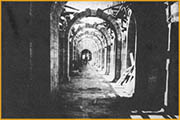
Construction of Gallery Vaults Under Mausoleum
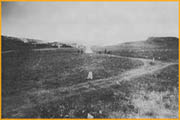
The appearance of Rasattepe from Tandoğan
The first phase of the construction, which involved leveling the landscape and building the Lions Road retaining walls, was contracted to Master-Engineer Hayri Kayadelen on February 9, 1944. “The Working Plan of the Anıtkabir Construction” was prepared by Prof. Emin Onat and the Chief of Zoning and Construction Works, Sırrı Sayan, and the chief controller of Anıtkabir, Ekrem Demirtaş, on May 3, 1945. Accordingly, the research for the balance and resistance of the Lions Road section was conducted by Master Engineer Ali Kranti, and the determination of the basic system and the ground survey was conducted by Prof. Hamdi Peynircioğlu. The first phase of the construction started on October 9, 1944 and was completed in October of 1945.
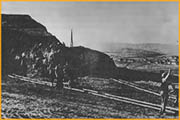
Leveling the Lanscape
West facade of the Lions Road retaining wall
At the meeting held at the Ministry of Public Works on February 12, 1946 to examine the groundwork and construction of Anıtkabir, considering the groundwork of Rasattepe where Anıtkabir was to be built, it was decided that the mentioned area was suitable for the construction and there were no technical obstacles for its construction as stated on the architectural project. Furthermore, it was agreed that construction with a "stone and reinforced concrete system" would be suitable to decrease the pressure of the upper part on the ground, to increase its resistance to earthquakes, and to formulize integrity and flexibility and that the effects of an earthquake would be taken into consideration on all static calculations of the building.
At the second meeting held at the Ministry of Public Works on February 13, 1946, it was decided that a foundation project should be prepared with the idea that the main block would not undergo major changes in the future. The project was to be prepared according to the “stone and reinforced concrete system” of the construction and by both taking into account a decrease in the foundation pressure and asking for the opinions of the authorities of the Ministry of Public Works and the engineers who would work out the static calculations. By the end of 1947, the groundwork excavation and insulation of the mausoleum had been completed and the iron mounting of the 11 meter-long reinforced concrete groundwork system that would prevent any subsidence was almost at the end. In addition, some parts of the supplementary buildings and the entrance towers were nearly completed. Most of the road layouts, some overlaying of the roads, the nursery facilities, field leveling, the roads in the park, forestation and the watering system were mostly completed. All of these costed 4,000,000 TL.
The building contractor company that undertook the second phase of the construction claimed that the work to be done was 20% over the tender price and they claimed that they could not finish the work as planned in the working program. However, their claim was found inappropriate by the Ministry of Public Works.
Due to the amendment of the project on February 1, 1946, the contractor company stated that the amount of concrete and iron they used was more than the estimated amount in the beginning and demanded the price disparity from the Ministry of Public Works, claiming that they were facing financial deficit. This demand was first considered to be reasonable and a price difference of 240,000 TL was to be paid. This issue was handled again by the Chairman of the State Council. However, the State Council finally decided not to pay the price difference demanded by the contractor due to the fact that the administration had the authority to make every kind of amendment on the project according to the contract dated July 7, 1947 and that the contactor was informed of this decision
On the one hand, the contractor company continued to work according to contract conditions; on the other hand, they filed a complaint against the Ministry of Public Works for a compensation of 2,000,000 TL in 1946. The case resulted in a favorable decision for the Ministry of Public Works. The contractor company was informed about the decision and the company was also warned that if they kept insisting on their assertion, the contract would be cancelled and a new tender would be hired. Upon hearing the disagreement with the contractor, the youth of Higher Education enthusiastically volunteered to work in the building of Anıtkabir.
The allowance of 10,000,000 TL, which was allocated to the construction of Anıtkabir according to law No. 4677 accepted in 1944, was later increased to 24,000,000 TL with law No. 5581 on March 1, 1950 and the second phase of the construction was accelerated.
The reasons for the extra allowance were presented to the Turkish Grand National Assembly on February 1, 1950 by the Prime Ministry and can be summarized as follows:
“Based on the allocation of 10,000,000 TL granted by law No. 4677, the tender of the monument to be inherited by next centuries was for an estimated cost. The construction was to be completed on December 31, 1949 and it started with a contract dated September 29, 1945. Even though the projects of the monument were prepared on the basis stone building, the groundwork area, which was found unsuitable for this heavy large block after various drilling activities, made it necessary to reconsider, the arrangement of the static calculations and to consider the effects of recent earthquakes occurring frequently in our country. As a consequence of some investigations carried out by a commission formed by the professors, including some professors from İstanbul Technical University; it was decided that the monument would be constructed in line with a system comprising of concrete skeleton and stonework, both the inner and exterior facades, for a lighter and connected large block. Anıtkabir, like other prominent works, was contracted through a variable rate principle due to both the change of the system and the tendency of the prices to decline at the time of contracting. It was noted that an extra allocation of 14,000,000 TL was needed to complete this construction with all its details because of the fact that an unpredicted increase in the prices had occured and that it became necessary for some more land to be expropriated. By the end of 1950, the middle floor of Anıtkabir, the supplementary blocks up to the roof, the rough work of the museum, the reception section up to the first floor, and the construction of the Lions Road and the entrance towers are to be completed. Later on;
- The expropriation of a 65,000 square meter area,
- The construction of the upper part of the middle floor in the Mausoleum,
- The completion of the rough work of the supplementary blocks,
- The implementation of all sorts of coating, woodwork, fitting, decoration and ornamentation of the buildings,
- The ground works of the park, , the retaining walls, forestation of the roads and the completion of all sorts of fitting will be carried out.”
On March 3, 1950, Şevket Adalan, the then Minister of Public Works, informed the Prime Ministry that the rough work in the second phase of the construction would be completed within that year. Following the additional allocation, it was necessary to determine the works to be done regarding the relief, statue and the Hall of Honor and other ongoing construction works. Therefore, it was decided to assign a commission consisting of members from the Ministry of Education, the Turkish Historical Society, Ankara University and, a representative from the Ministry of Public Works, and the architects of the project. The Second phase of the construction was completed on August 8, 1950.
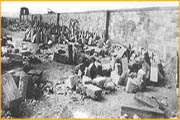
Western Facade of Lion's Road Retaining Wall
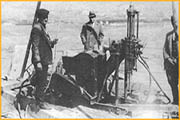
Drilling in the area
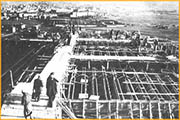
Block and concreting operations in the Mausoleum
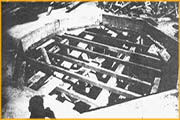
Concrete ground of the Tomb Room
The third phase of the Anıtkabir construction consisted of the roads to the monument, the stone pavement of the Lions Road and the Ceremony Square, the stone pavement of the mausoleum’s upper layer, the construction of the steps of the stairs, the placement of the sarcophagus stone and making necessary fittings. Amaç Ticaret A.Ş (a joint-stock company) was contracted for the 3rd phase of the construction on September 12, 1950. The contract price was 2,800,000 TL.
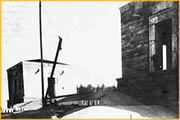
Construction of the Entrance Stairs
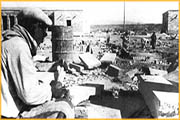
View of the Ceremony Square from the Lions Road
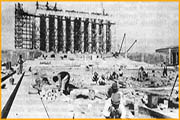
View of the Ceremony Square from the Lions Road
The fourth phase of the construction included the construction of the pavement of the Hall of Honor, the pavement of the vaults, the stone profiles around the Hall of Honor and the ornamentation of the fringes. The construction of this phase was assigned to contractor Muzaffer Budak.
On November 20, 1950, a commission formed by consisted of Professor Paul Bonatz, Professor Sedat Eldem, Professor Emin Onat and Associate Professor Orhan Arda held a meeting under the chairmanship of Muammer Çavuşoğlu, the Permanent Undersecretary of the Ministry of Public Works, to investigate whether the construction of Anıtkabir could be finished at a lesser cost and more quickly, and to present the results of the report to the government. The opinions put forward by this commission can be summarized as follows:
- The most significant modification, which is considered sufficient for the time being, is to cover the platform in the Hall of Honor, to be completed soon, with stones and to place the sarcophagus on it. Even though the main part of the Mausoleum is to be removed after carrying out the construction, completing the supplementary buildings and landscaping the squares this winter; we are of the opinion that this situation is not acceptable regarding the personality of the Great Leader and the act of placing the sarcophagus alone on this monumental area does not create a great impact.
- The second opinion is that in addition to the sarcophagus on the main platform building the exterior columns and the mouldings between these columns would be sufficient. In such a case, the aimed dignity and the nobility will not be provided. Naturally, there is a chance of completing the monument according to old plans and projects. However, the commission is in the favor of having an exact result, no matter how simple the plan is, rather than creating a half-completed or temporary job.
- The third opinion is to cancel the section that rises over the colonnade of the Mausoleum. This can be analyzed in two ways;
a. After the cancellation of this section, what will the exterior appearance of the building be like?
b. What will the possible effects of the abovementioned implementation to the interior of the construction be?
After analyzing on a 1/100-scale model, investigating the construction site and controlling this view from various points of the city, our committee unanimously agreed that the block on the columned section is not absolutely essential in terms of exterior view. After analyzing the 1/100-scale model, studying the construction site and controlling this appearance from various points of the city, our commission unanimously agreed that the block on the colonade section is not absolutely essential in terms of exterior appearance.The monument can even gain more nobility without it. Thus, cancellation of the large block on the colonade section is not a change that will ruin the beauty of the monument. In terms of the interior apperance, a comperensive change is required. Covering the Hall of Honor with a low ceiling would be rather poor in comparison to the sublime effect of the present project created by its high volume. Therefore, the interior architecture is to be modified. If this modification is set in a style surrounded by architectural elements and with an open-top, the old high volume will not be needed. If the government gives up the idea of a covered Hall of Honor, approves this form and accepts that the sarcophagus be placed in an open area surrounded with walls, the monument will become much simpler. The real grave is in the soil, one storey beneath the platform. The grandeur and the nobility of the great granite sarcophagus will not diminish when exposed to all sorts of weather conditions of all seasons and when under the sky during day and night. The members of the commission including the monument architects are of the opinion that a monument with a different effect and beauty could be built this way. The aforementioned amendments of the plans, reduction of the volume to be constructed and simplification of the construction will provide significant savings from time and money.
The commission report was reviewed and accepted by the Council of Ministers. The Minister of Public Works, at a press conference on September 30, 1950, stated that with this amendment Anıtkabir could be completed in 1952; thus, they would gain two years time and make a saving of 7,000,000 TL on the cost of construction and expropriation.
Professor Emin Onat, in one of his articles, explained the fourth amendment as follows: “On December 4, 1951, the government asked the architects whether there was a chance to provide a reduction from the construction time by decreasing the 28 meter-height of the Hall of Honor in the second project. As a consequence of the studies and the models that we prepared, we saw that raising the colonade section could reduce this height and this could be provided through covering the Hall of Honor with a concrete ceiling instead of a stone vault. This situation would eliminate the technical drawbacks of the stone vault structure which would bring about major difficulties in terms of an earthquake”.
Agreeing with the architects, the government abolished the idea of constructing the Mausoleum with four surrounding walls on which there were reliefs depicting the National Struggle and the Turkish Revolution and carried out the project as it is today.
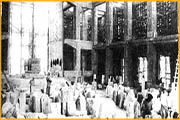
The concrete skeleton of the Mausoleum

Excavations of the front stairs of the Mausoleum
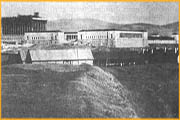
The south-west appearance of the Anıtkabir construction.